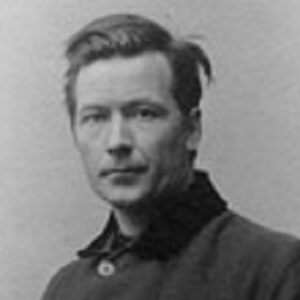Iceland’s first sculptor was Einar Jonsson. He lived at an era when there was no tradition of sculpting in Iceland, and he established the art of sculpture in his birthplace, making him a pioneer in the discipline. From a young age, he was very creative and artistic, and he was intrigued by all sorts of fine arts. He wanted to pursue sculpture as a student, so he travelled to Denmark to study at the Copenhagen Academy of Art. He was then awarded a scholarship to study in Rome, where he completed an apprenticeship and lived for two years. He had gotten a traditional education in classical sculptural method, but he was a maverick at heart, and it wasn’t long before he began to question established sculpture style conventions. His works gradually drifted away from the classical standard, becoming characterized by powerful motifs that aroused sentiments of love and romance. He was also unusual in that he preferred to work with Plaster of Paris rather than modeling clay because it allowed him to concentrate on a single piece for years. He gave all of his paintings to the Icelandic people as a gift, and they are now on display at the Einar Jónsson Museum in Reykjavik.
Childhood and Adolescence
Einar Jonsson, the son of Gróa Einarsdóttir and Jón Bjarnason, was born on May 11, 1874, in Galtafell, a farm in southern Iceland.
In 1888, he received his first communion at the Hrepphóla church. He had always been bright and inventive since he was a child.
In 1889, he visited Reykjavik for the first time and saw a collection of paintings in a parliament building for the first time. The overwhelming beauty of the works of art touched him greatly, and it encouraged the artist in him.
In 1891, he travelled to Reykjavik to study at the Hermes Commercial School. Torfhildur Hólm, an Icelandic author, taught him English and sketching. He had already resolved to pursue a career in the fine arts at this point.
In 1893, he travelled to Copenhagen, Denmark, to study wood carving under Sophus Petersen and C.B. Hansen. The next year, he enrolled as a pupil of Norwegian sculptor Stephan Sinding and began evening classes at Tekniske Selskabs.
He also studied drawing at Gustav and Sophus Vermehren’s school between 1894 and 1896.
Einar Jonsson studied at the Royal Danish Academy of Fine Arts in Copenhagen from 1896 to 1899. Wilhelm Bissen and Theobald Stein.Jónsson were his mentors at the academy. In 1901, he showed his first publicly exhibited painting, ‘Outlaws,’ at the Spring Salon in Copenhagen.
In 1902, the Althing, Iceland’s parliament, granted him a two-year scholarship to study in Rome. During his time in Rome, he understood that the classical art tradition limited artists’ freedom and required them to comply to traditions. He became a harsh critic of traditional art and a staunch opponent of naturalistic depiction.
In 1903, Einar Jonsson displayed his work ‘Man and Woman’ at an art event in Vienna’s Das Kunstlerhaüs. He aspired to be unique and refused to follow in others’ footsteps. He was influenced by German symbolism and created a figurative language based on symbols and allegories.
He first appeared in Die Frie Billedhuggere concerts in 1905, and he would maintain this tradition until 1909. In 1906, the artisan organization commissioned him to create a statue of Ingólfur Arnarson.
He worked on a memorial in memory of Icelandic poet, author, and naturalist Jónas Hallgrmsson. In 1907, the statue was unveiled.
He proposed to donate all of his works to the Icelandic people in 1909. In exchange, the Althing promised him a home and studio in Reykjavik. The art works would be housed in a museum, it was decided.
In 1916, Einar Jonsson planned to build a museum at the top of Skolavorduhaed, and construction began. In conjunction with Architect Einar Erlendsson, he designed the museum. The Einar Jonsson Museum first opened its doors in 1923 on Midsummer’s Day.
He created several private works for the sake of art throughout his later years as he became increasingly inclined to spirituality as a sculptor, in addition to works for financial considerations. These works included the ‘Birth of Psyche,’ ‘Fantasy on Yggdrasill, the Tree of Life,’ and ‘Thor Wrestling with Old Age.’
Major Projects of Einar Jónsson
Einar Jonsson made several public monuments in the commemoration of prominent people throughout his lifetime. ‘Christian IX’ (1915), ‘orfinnur Karlsefni’ (1920), ‘Hallgrmur Pétursson’ (1922), ‘Ingólfur Arnarson’ (1924), and ‘Hannes Hafstein’ (1925) are only a few examples (1931).
He obtained private commissions for portraits and grave monuments in addition to the public monuments for which he was commissioned by the government. ‘Memorial to the Eisert Family of Lodz’ (1935), ‘Monument to Dr. Charcot and His Ship’ (1936), ‘Memorial to a Lost Airliner’ (1952), and several grave markers are among his most notable private commissions.
Personal History and Legacy
In 1901, Einar Jonsson met Anna Marie Jrgensen at a new year’s ball. They quickly fell in love and soon engaged. They did, however, have to wait several years to marry, finally marrying in 1917.
He lived a long and busy life, dying in Reykjavik on October 18, 1954, at the age of 80.
Einar Jonsson Net Worth
Einar is one of the wealthiest sculptors, as well as one of the most popular. Einar Jonsson’s net worth is estimated to be $1.5 million, according to Wikipedia, Forbes, and Business Insider.


